
Spirit and matter are not opposite to each other.
They are two sides of energy,
And they transform each other.
Matter is the carrier of spirit,
And spirit keeps in the material transformation.
Its energy is released to dissolve,
The dissipation of energy stimulates further mental activity.
This constitutes the energy ecology between spirit and matter.
—Zhu Zheqin
Editor’s note: The 17th International Architecture Exhibition La Biennale di Venezia, which has experienced delays, twists and turns with online exhibitions resulted in Pavilion of P.R. China presenting an exhibition themed on “Yuan-er, from the mega to the micro” and it aims to study and present the different connotations of “courtyard”(Yuan-er) in the Chinese cultural space, and further respond to “How Will We Live Together”, the theme of the 17th International Architecture Exhibition La Biennale di Venezia, which is a proposition full of reflection, imagination and exploration of the common destiny of human beings.
Among the artists, sound artist Zhu Zheqin (a.k.a. Dadawa) was invited to create and exhibit the sound art work “Courtyard in Four Phases” for the Pavilion of P. R. China. In recent years, Zhu Zheqin’s sound art creation has begun to focus more on exploring the transformation of “energy” through multiple media. As the Sound Art No. 07 work created by the artist since 2014, “Courtyard in Four Phases” takes “sound as architectural material”, trying to transcend the time dimension of sound and the physical dimension of architectural space, through “phases”, to realize the energy interaction and conversion of the visual orientation/auditory phase, and deduce the building of material form in people’s thinking patterns into an energy flow that occurs in dynamic space and time.
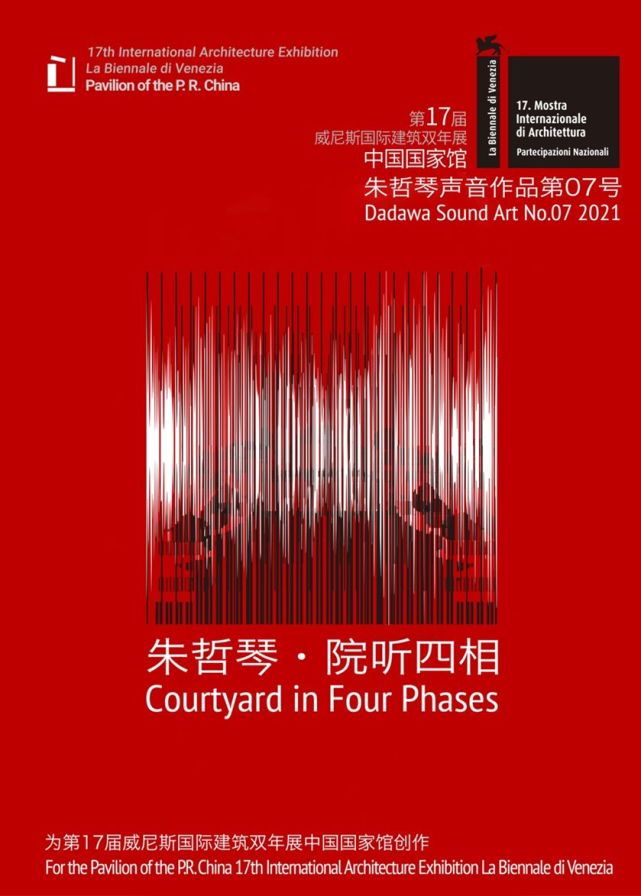
The Visual Poster of “Yuan-er, from the mega to the micro” for the Pavilion of P. R. China that Zhu Zheqing attended at the 17th International Architecture Exhibition La Biennale di Venezia
“Listening to Yuan-er”, that is, “hearing from architecture” means a process of feeling the energy from the subject to the object. This performance summons the viewers to experience the flow, transformation, aggregation and even birth and death of energy in an imaginary “auditory building” constructed by time, sound waves, phases and energy flow. Confronted with the post-pandemic era where life and death continue to gather and disperse, Zhu Zheqin tries to use her “Courtyard in Four Phases” to explore an abstract, macroscopic but increasingly important issue of how spiritual energy and the material world interact with each other: “is there a possibility that some energy got us here, what kind of energy shall we start with, and where can this energy lead us to?”
How to incorporate sound into architectural materials? How to imagine “l(fā)istening” to a building? In an interview with CAFA ART INFO, the artist started from “Courtyard in Four Phases” to explain how she connected sound waves and phases with music and architecture through sound installations, and further connected people’s spiritual and material world in the energy exchange between time and space.
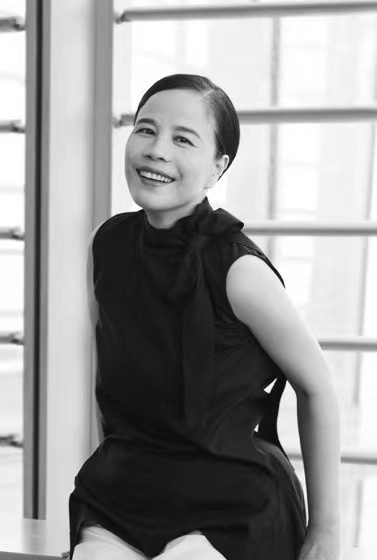
Interview with: Zhu Zheqin
Interviewer: Mengxi
Translated by Sue/CAFA ART INFO
CAFA ART INFO: The theme of the 17th International Architecture Exhibition La Biennale di Venezia that you have participated in is “How Will We Live Together”. “Yuan-er, from the mega to the micro” is the theme for Pavilion of P.R.China, and what is the connection between your “Courtyard in Four Phases” and these two themes?
Zhu Zheqin: This time, Pavilion of P.R. China responds to the proposition “How Will We Live Together” with “Yuan-er, from the mega to the micro”. This exhibition abstracted the unique and representative Chinese architectural model “Yuan-er” and its living form to discuss the state of peoples’ co-existence activities, as well as the problems they face and future prospects that are relevant to the theme and have far-reaching significance. “Yuan-er” is an outlook on life and the world presented by the Chinese people’s high degree of integration of nature, human relations, aesthetics, and values between human settlements and nature, and it has a symbolic meaning of neutrality and universality.
Over 100 architects’ design projects were displayed at the Pavilion of P.R. China. The professional content of these building physics has been very profound. I think sound creation can focus on the abstract side of architecture, which is exactly the role and significance of sound creation in architecture. In the physical space and time of the exhibition, the corresponding energy, spiritual attention and exploration are carried out as well. Music and architecture have a lot in common, and sound can be an abstract physical space. From these potential energy flows, I can observe the influence of human movement and energy on everything around.
 Exhibition View
Exhibition View
CAFA ART INFO: Where did the inspiration for “Courtyard in Four Phases” come from...?
Zhu Zheqin: The inspiration for “Courtyard in Four Phases” came from the 600-year-old Forbidden City. The 17th International Architecture Exhibition La Biennale di Venezia was originally scheduled to open in May 2020, coinciding with the 600th anniversary of the Forbidden City. In the beginning, the curatorial idea for the Pavilion of P.R. China was extended from the concept of the Forbidden City—Yuan-er. And this magnificent dimension of time inspired my creation. Being a building complex that has traveled through hundreds of years of time and space, when it was completed as a physical building, its physical properties have been fixed. However, the life of architecture in time and space has just begun.
In the life history of architecture, its life is the energy brought by the movement of people in the physical space of the building and the life endowed by its transformation, birth and death, aggregation and transformation. It is alive, it has undergone germination, growth, transformation and rebirth, and it is still growing, it is a group of living beings, and individuals that converge into a group-energy flow. It may be an abstract interpretation of the “Yuan-er”, or it may be the pursuit, participation and imagination of the past and the future.
CAFA ART INFO: Please talk about the creative concept and structure of “Courtyard in Four Phases”, for example, how does the work mix and construct the visual and auditory aspects?
Zhu Zheqin: The internal structural logic of architectural construction and the construction of music are surprisingly similar. In the sound creation, the architectural model of “Yuan-er” is abstracted into all directions. I want to interpret the static and solid exhibition site into a dynamic space-time. Let the sound waves achieve the bearing and distance experienced from the hearing through phases. The visual orientation-auditory phase is transformed and interpreted interactively.
The “Courtyard in Four Phases” that I conceived is a multi-phase live interactive sound work. Through the early-stage and on-site sampling technology, digital editing audio equipment and computer workstations, I have conducted multi-phase sound interaction across time and space, and I used the abstract auditory “Yuan-er” as an open container for the energy field to take the time and movement frequency as a carrier, through the interaction of different phases in dual time and space, we can feel and participate in the transformation, aggregation, birth and death of energy.
In this massive sound installation, what you see is not what you hear! Time, sound waves, phases, and energy flow jointly construct an imaginary auditory building. Sound abstracts the building in all directions, expanding the time-space extension of the enclosed building, where vision and hearing are unfolded in different dimensions.
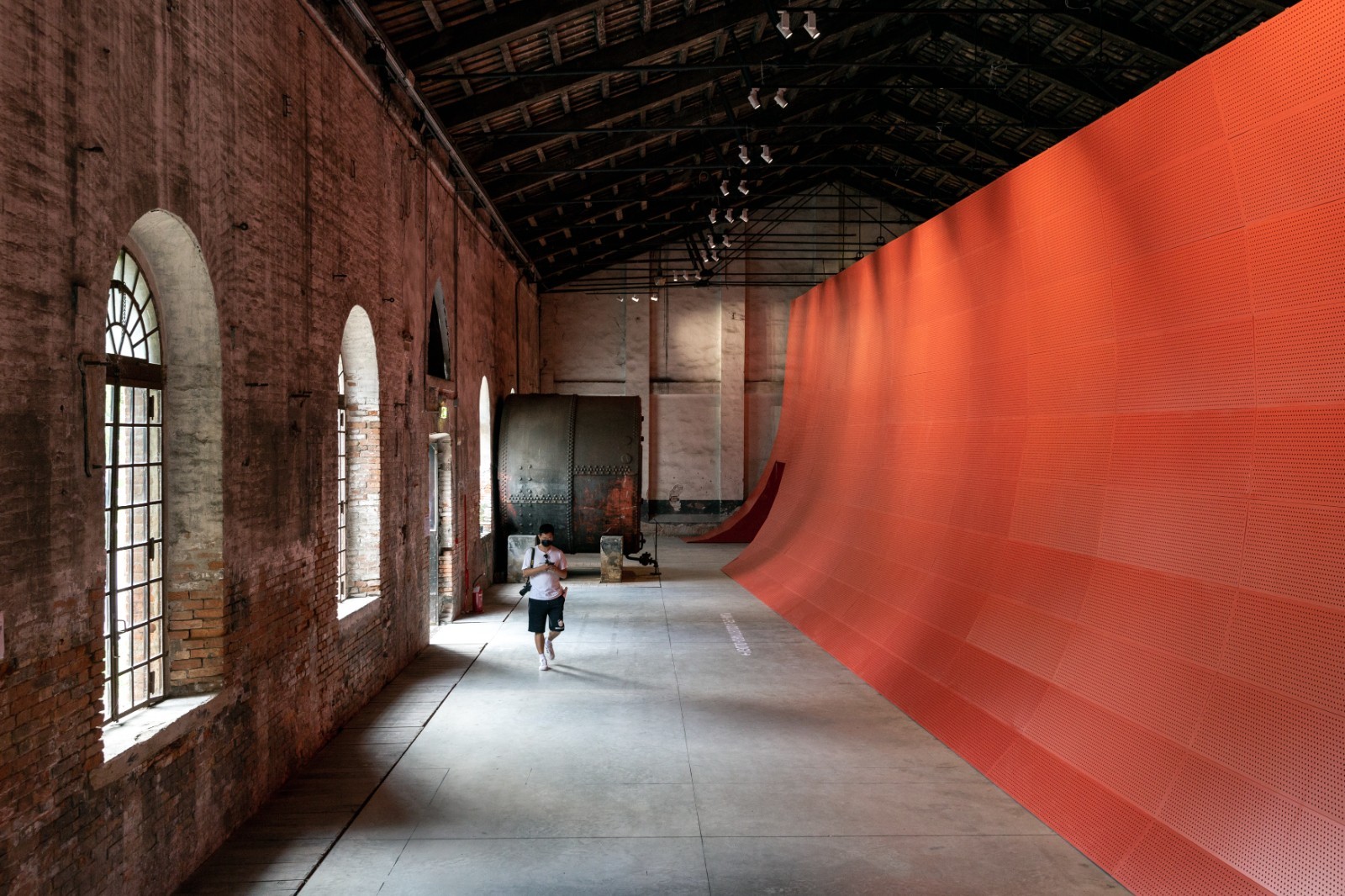 Exhibition View
Exhibition View
CAFA ART INFO: You once said that “Courtyard in Four Phases” is not about “Hearing from Yuan-er”, but a reconciliation, “Yuan-er Listens”, how did your work reflect such a realm?
Zhu Zheqin: The fascinating thing about architecture is that the subject and the object are always in a coexisting and changing relationship in time and space. This makes me feel especially inspired. It also made me more interested in the flow of energy in the static and the dynamics of representation.
Architecture is a container created by human beings for their own existence. Although people feel that they are the creator of the building, as if they are the eternal subject of the building, but over a large time scale, individuals have become the objects of the building. Such a perspective and way of thinking can make people feel the life and induction of physical buildings in large-scale time and space all at once.
Therefore, the creation of “Courtyard in Four Phases” is reversed. Taking a static physical space as an auditory subject, I trust the theme was “Yuan-er Listens” rather than “l(fā)istening to Yuan-er”. “Yuan-er” is regarded as a space-time container, and it is allowed to “l(fā)isten” and observe the birth, growth, ups and downs, flow and reincarnation of energy... and its cohesive power, and that’s what people who have been there have given it. Physical architecture cannot speak, it is silent. It is always listening. Let those who come and go say. Its life is from the moment of its birth, that is, every individual and every group moves forward and backward in time. Perhaps it can also be said: Architecture is the space-time carrier of energy.
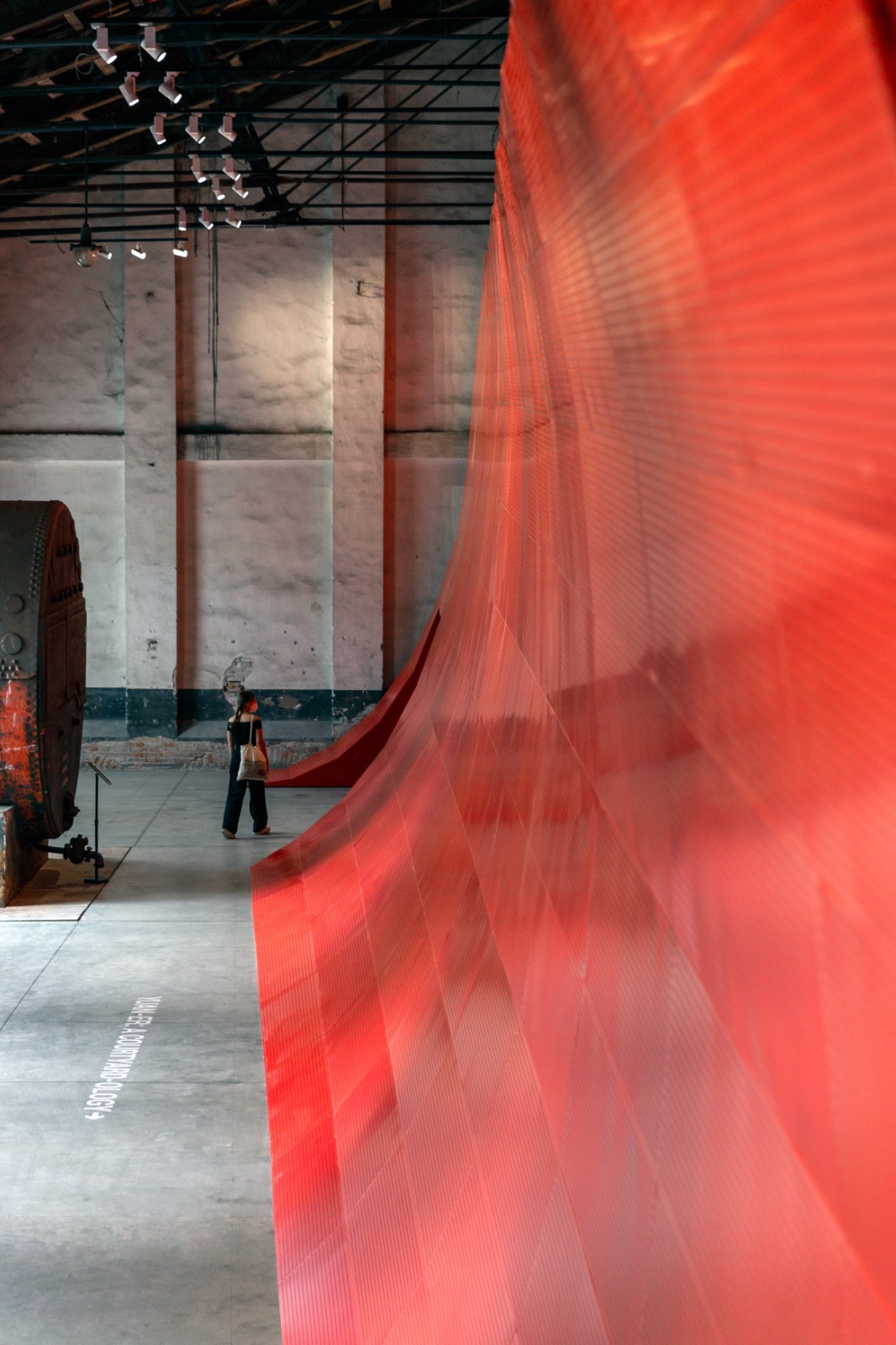
Exhibition View
CAFA ART INFO: As a sound art work, how does it relate to the building it is in? What kind of relationship does it have? How can sound be used as a building material to construct “auditory architecture”?
Zhu Zheqin: “Architecture is still music”, “Music is flowing architecture”. This sound work is actually 5 minutes of sound plus 1 minute of static rest before and after, a total of 6 minutes. By transforming physical buildings into auditory buildings, I want to use sound to abstract energy’s birth and death, and to use sound to observe the trajectory, speed, ups and downs of movement.
Here, time is both a scale and a container, shared by buildings, sounds, and people. Space transformation is a phase in sound architecture, which can realize the interchangeable interpretation of a visual orientation and auditory phase. The two elements of “time” and “phase” realize the transformation and sharing of virtual and real physical buildings, and become the two major frameworks of on-site auditory architecture.
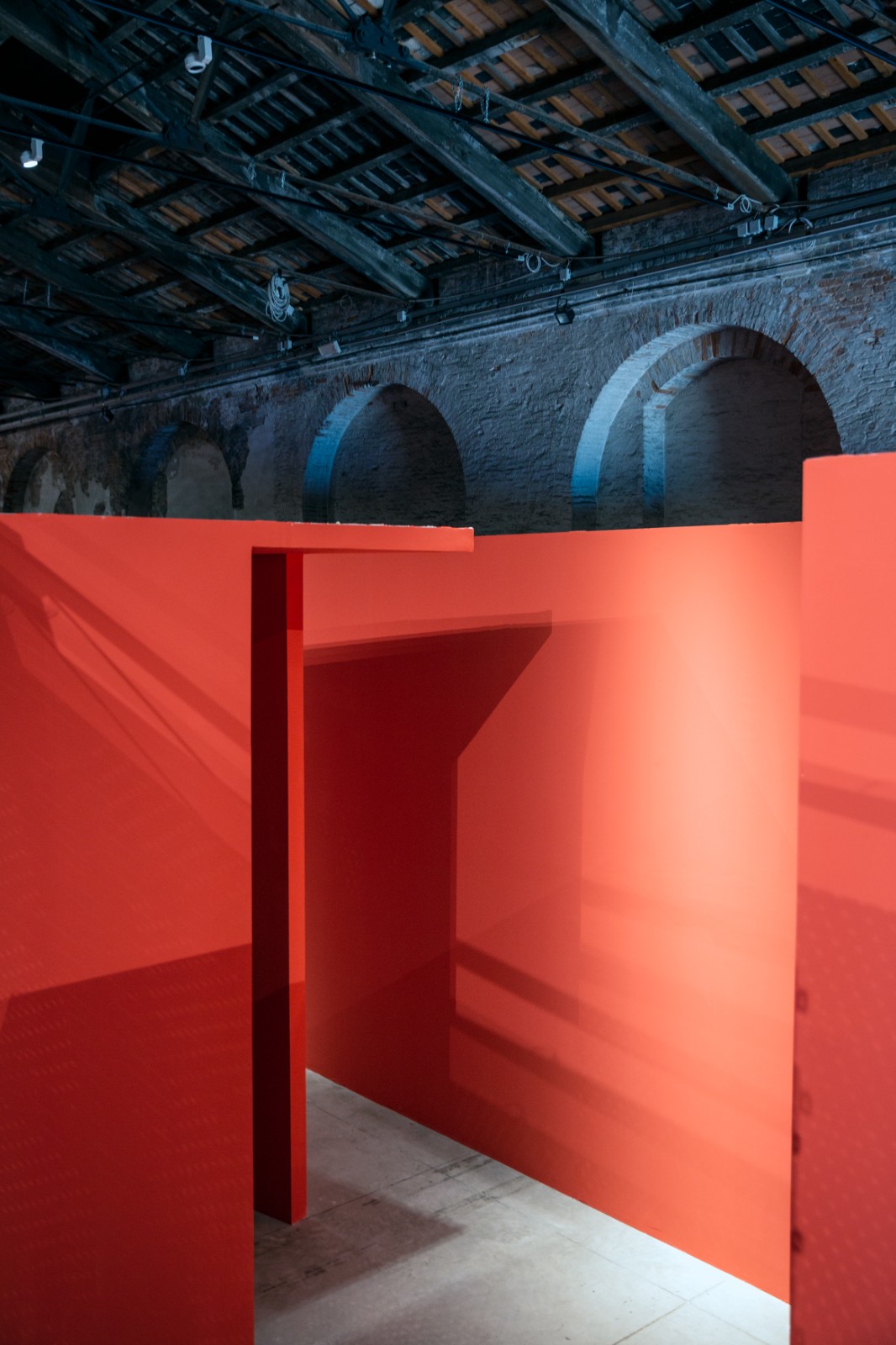
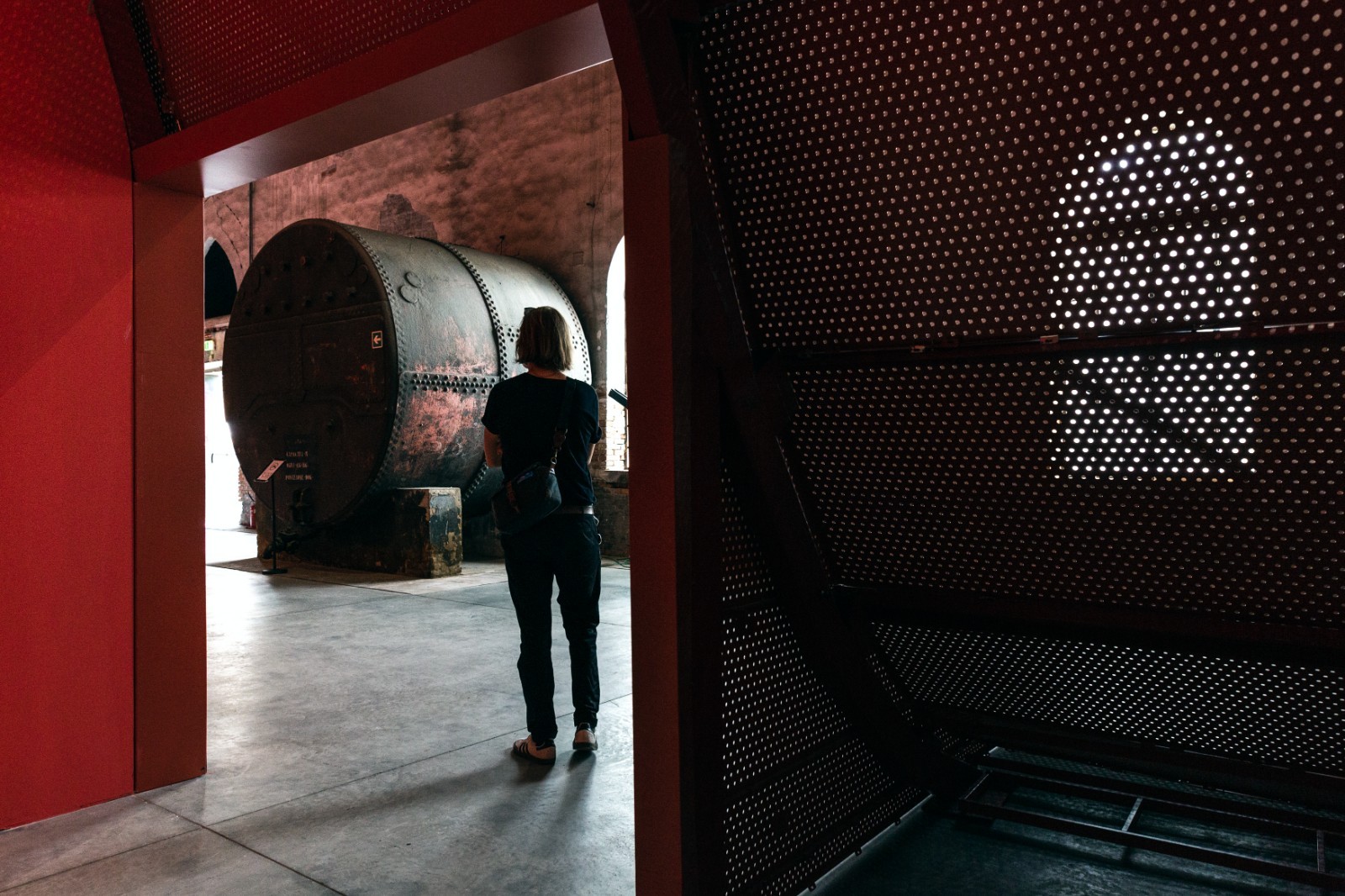 Exhibition View
Exhibition View
“Sound waves” are building materials that contain four sound elements: time, gait, vocals, and energy flow. This time, the vocals are separated from the ideographic sentence narration, but the sound is decomposed into syllables, and the combination and arrangement of the matrix are carried out. Sound waves form motion and auditory induction of points, lines, and surfaces in the field. Combining the on-site architectural space and the arrangement of the exhibition, the on-site sound phase arrangement has been boldly set, as the “gait” sampling of the main sound material, and the preliminary arrangement interacts randomly with the steps of the live audience, thereby constructing a lively interventional dynamic sound architecture.
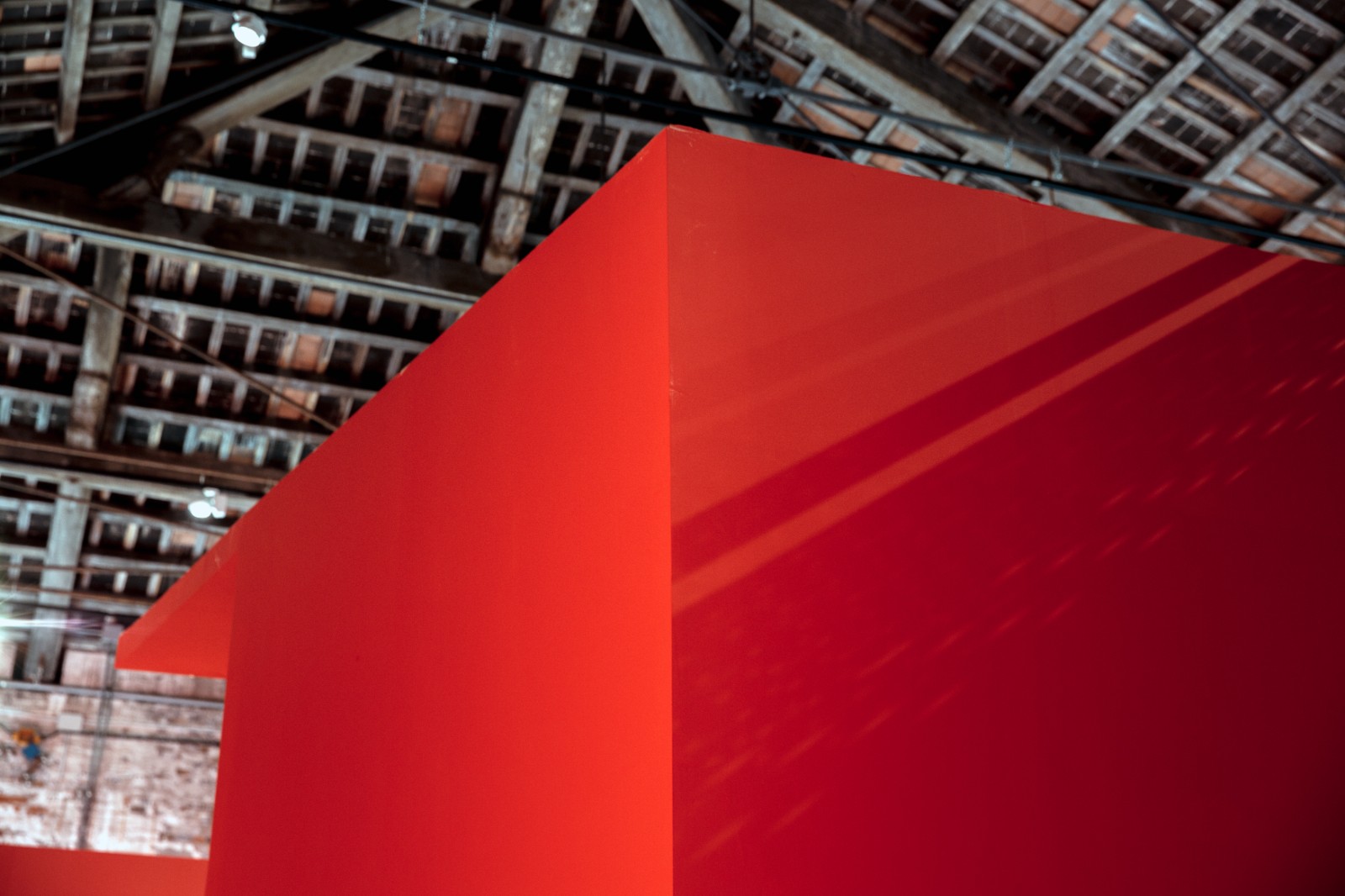
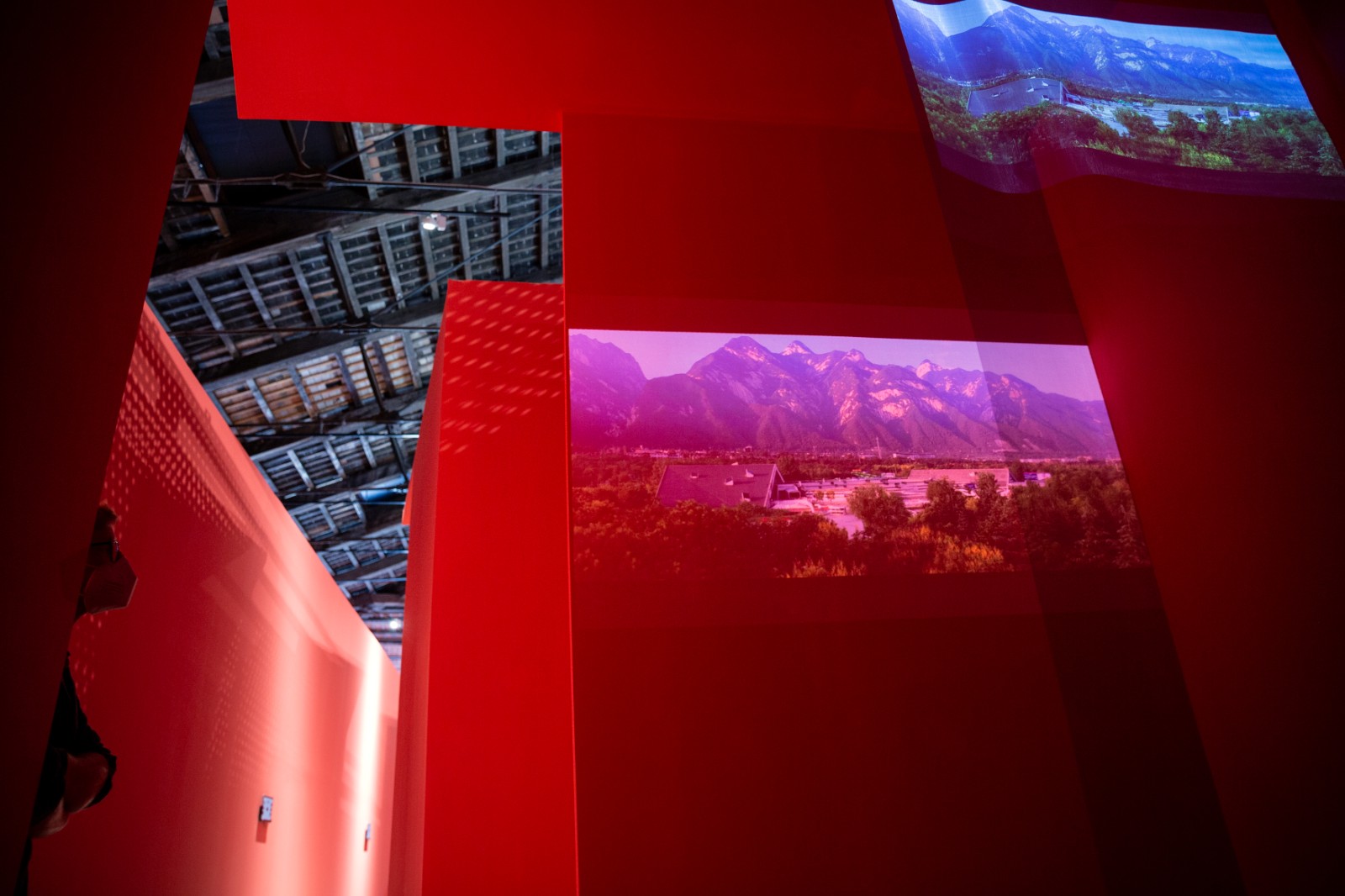 Exhibition View
Exhibition View
CAFA ART INFO: “Courtyard in Four Phases” are the four dimensions of “time-space-motion-energy.” Compared with the three-dimensional dimension of Western physics, the Chinese dimension expression seems to be more spiritual. Your sound art creation in recent years mainly focuses on this spiritualized energy, how can we understand “energy”?
Zhu Zheqin: “Courtyard in Four Phases” in English refers to four phases in Chinese: time-space-motion-energy, the four dimensions are the same but different. I think “xiang” in Chinese is more accurate. In Western learning, dimensions are used to describe space, and it is more inclined to the physical world. The Chinese physiognomy, although it also refers to the physical state, is one with two sides, and is more inclined to spirituality.
From the point of view of physics, the easiest way to examine the living body is to consider it from the perspective of motion and energy. Energy is the building block of all matter. It is the role and response of one person/thing to the other. Energy is produced in time-space-motion, and energy also produces “entropy” while acting. Life lives on “negative entropy”, which offsets the increase in the entropy it generates. Motion-energy-entropy are one. What determines the movement and the flow of energy is the human will. The Tao of the ancient Chinese and “harmony between man and nature” are the balanced solutions proposed by the profound cognitive understanding of the physical world, and have risen to a philosophical spirit and world view while also influencing the concepts and aspects of Chinese architecture.

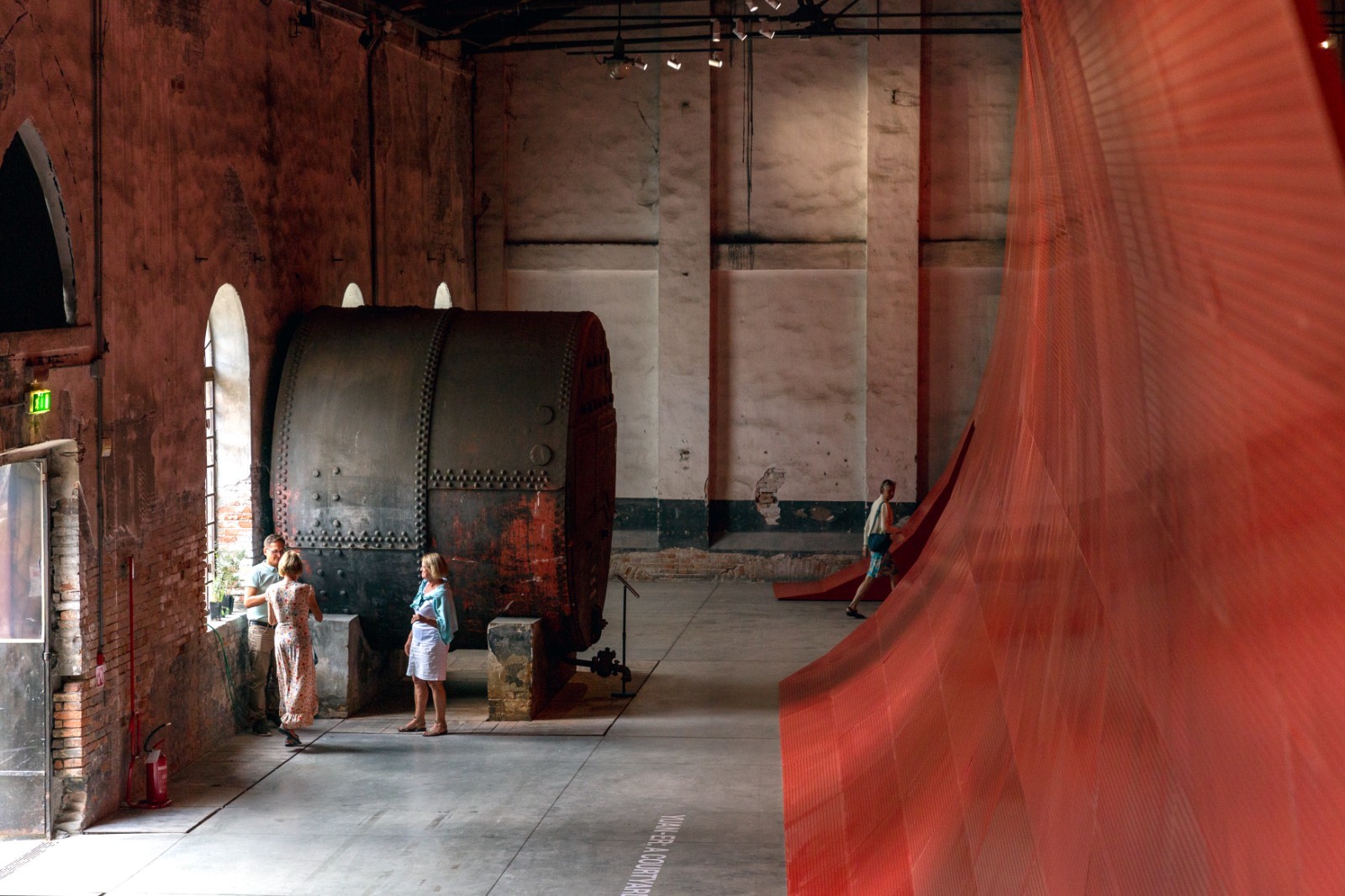 The Interior and Exterior of Building
The Interior and Exterior of Building
CAFA ART INFO: What kind of experience do you want people to get from your work? How did the audience respond on the scene?
Zhu Zheqin: Although the exhibition has been postponed for more than a year, due to the pandemic, we cannot go to the site during the entire planning and exhibition period. The plan has been revised several times, and the technical realization is also adjusted according to the limitations of the conditions. Our creative team was ready to do what we can even without any audience. From the limited pictures on scene, we did not know the response from the scene. I hope that the viewers who come to visit the exhibition are also the authors of the scene!
The physical side of the building is static, it is the container. It is the carrier of motion, energy and entropy. And I want the audience to perceive what’s below the physical level. In the courtyard space where we live together, everything changes with the intervention of people in time and space. Here, individuals converge into a flow of energy that transforms the world and its surroundings.
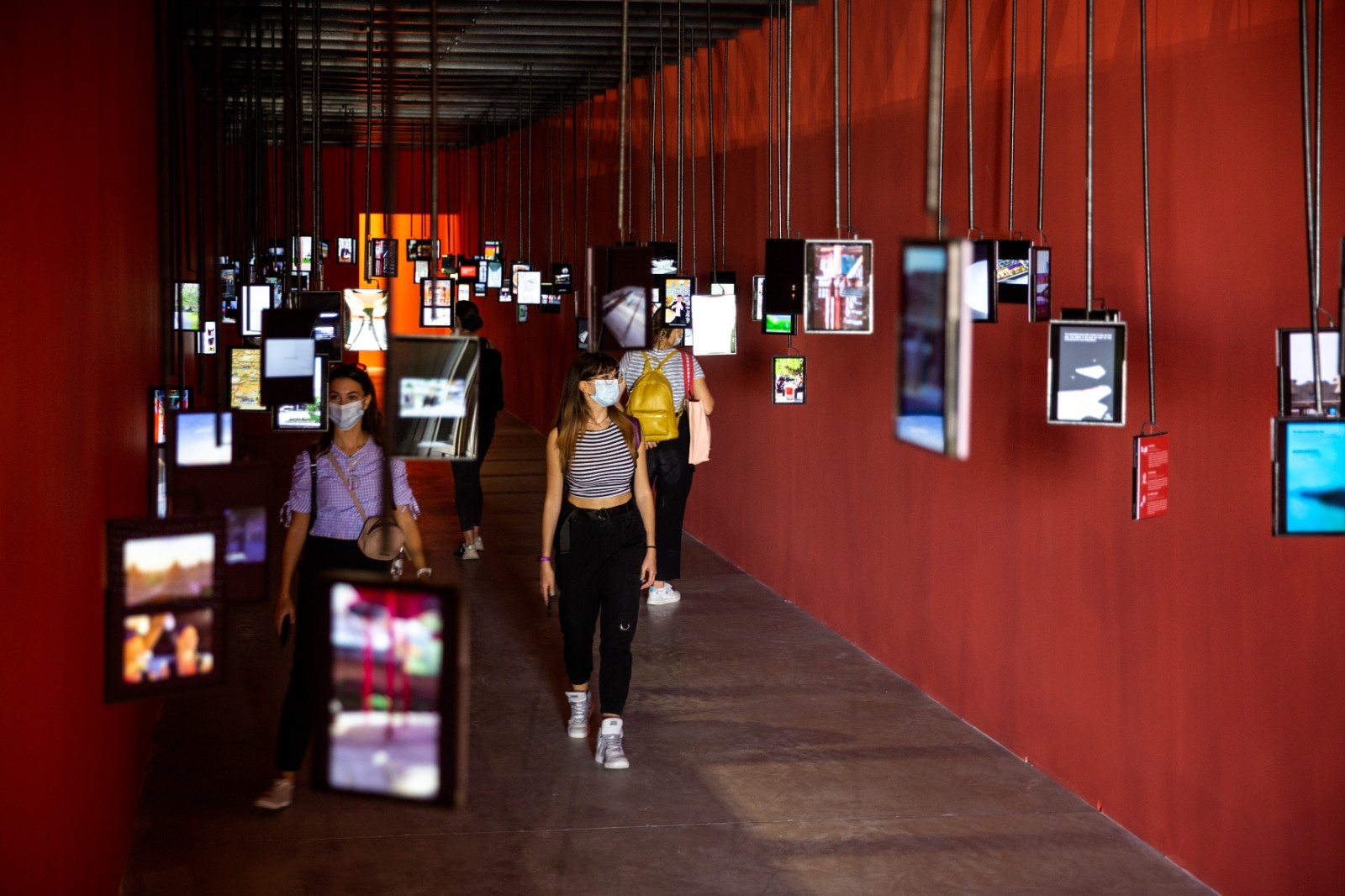
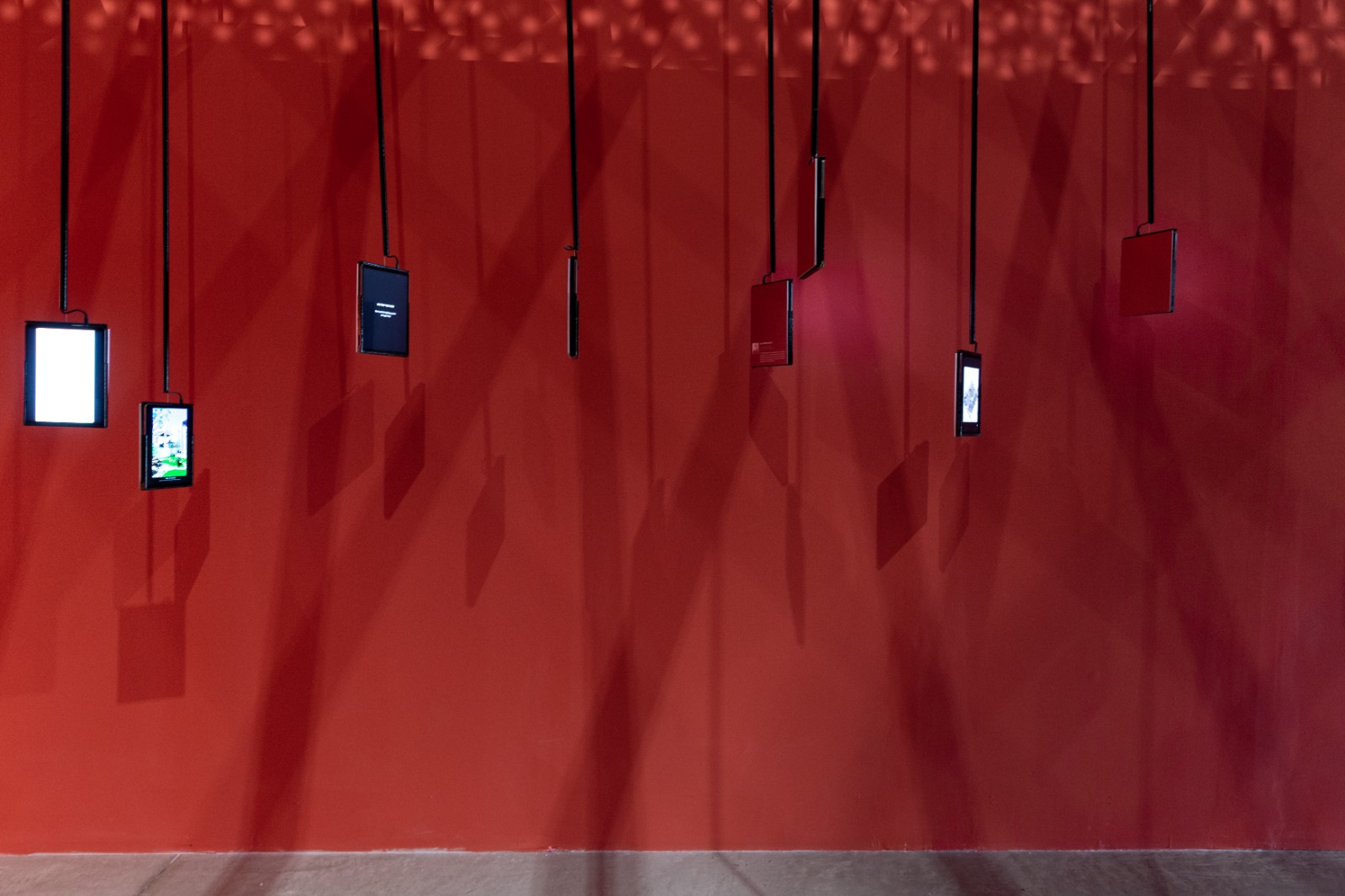 Exhibition View
Exhibition View
CAFA ART INFO: Against the background of isolation and closure caused by the pandemic, what can sound, or “energy” bring to the world?
Zhu Zheqin: Is there a possibility: what kind of energy brought us to today, what kind of energy should we restart, and where should this energy lead us to?
The secret to the existence of life on Earth depends on the orderly delivery of energy flow. It depends on the dynamic balance of motion-energy-entropy.
High speed, expansion, diversity, iteration, and change in the current situation... and the fearful, sensitive, fragile, and seemingly vulnerable lives in the two-year pandemic crisis... This is a problem that no one can ignore or avoid. This is a particularly good question! It is also what I have been asking and pondering since I started doing sound art, especially over the past two years...
 Image Courtesy of the Artist.
Image Courtesy of the Artist.




























